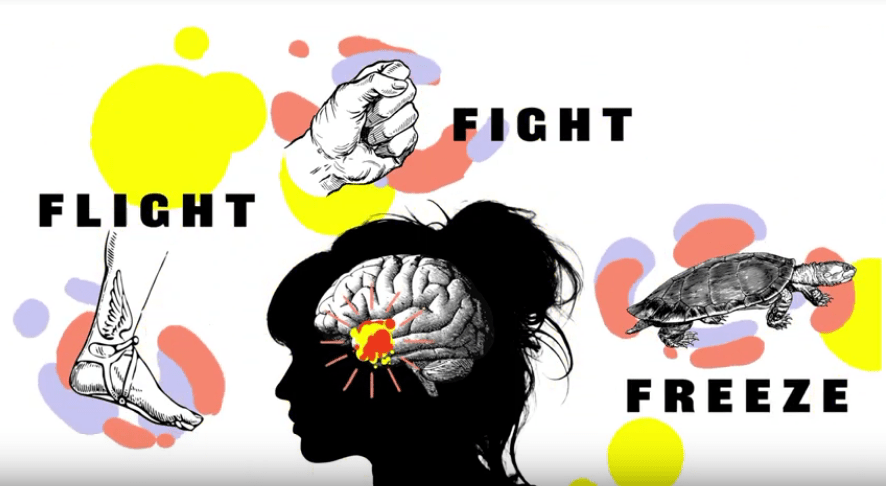What do you do when a bear is chasing you? You have four options: fight, flight, freeze, or fawn. These are the responses that your body will go into depending on what you perceive to be a threat. It’s important to understand these responses and their meaning for survival so that we can better help those who have been traumatized. This blog post will explain them in more depth and offer some tips on how to best respond if they happen again in the future.
Contents
What Are Fight And Flight Responses?
A fight or flight response is an instinctual reaction to a perceived threat. Your body has a way to protect itself when there is danger. It can either fight the danger or run away from it.
The fawn response falls under this umbrella because its purpose is also to defend oneself. However, instead of battling the enemy like in the case of fight and flight responses, with fear and aggression respectively; you freeze where you are and make no noise. This minimizes your chance of being caught which makes escaping easier later on.
The fawn response is usually seen in animals that are preyed upon, like deer. Predators tend to go for the weak and vulnerable members of the herd first, so by playing dead, the deer reduces its chances of being killed.
This tactic also works well against those who aren’t looking to kill their prey outright, like a lion that wants to take its time-devouring its meal. The fear response will keep the animal alive until it can make a run for it when the coast is clear.
What Are The Freeze Response?
This tactic is a form of fawn response. In the case of freeze responses, your body goes into overdrive to prepare itself for whatever danger lies ahead. It does this by slowing down all metabolic functions and producing chemicals that make you feel numb from head to toe.
This makes so painful situations seem like they’re not as bad as they actually are and allows you “play dead” until you can escape or devise another way out.
One example of this would be If an animal is caught in a steel-jaw trap, its instinct tells it to stay still. This will prevent more pain.
You could compare this with how we hold our breath during trauma so that we don’t make any noise and potentially give away our location. The freeze response is seen in both animals and humans. In some cases, it can be a matter of life or death.
What Are The Fawn Response?
As mentioned earlier, the fawn response is usually used by prey animals to defend themselves from predators. This can take different forms such as playing dead, freezing up, or running away.
All of these tactics have one common goal-to reduce the chances of being detected and killed. And while this might seem like a last resort, studies have shown that it actually works quite well in most situations.
In fact, out of all the possible responses to danger, the fawn response is the most effective. It’s even been called “death feigning,” since it can make you appear dead to predators when in fact you are still alive and able to defend yourself if things get too dangerous.
How Do These Responses Work?

It all comes down to your evolutionary past and how it’s shaped these behaviors.
A lot of what we do today is influenced by our genes, which are the driving factors behind why people act certain ways in specific situations (especially when their lives or those around them are at stake).
This means that depending on where you come from as a species; fawn response might be more natural for some than others.
Flight And Fight Responses
- These responses are a bit harder to explain since they’re not as universal.
- In the case of flight response, it simply makes sense that our bodies would go into overdrive when there is danger lurking around.
- This can take many different forms such as increased heart rate and breathing which lead up to running away from whatever or whoever poses a threat.
- With fight response, however, this isn’t quite as straightforward because your body doesn’t automatically know what to do in every situation.
- It just knows how to prepare itself for battle against an enemy regardless of whether you will win or lose.
Freeze And Frawn Responses
- Since you’re likely to avoid danger when possible, your body slows down all functions until the threat passes.
- This is a form of self-preservation that has been around ever since humans first walked on Earth and it still serves us well today
- In some cases, however, people might revert back to primal instincts instead of responding rationally in certain situations (for example: freezing up or having panic attacks).
- We have two ways of reacting to things. One is like a deer, and one is like a fighter/runner. The way we act now depends on the history of what has happened before.
Responses to Fight, Flight, Freeze, and Fawn Situations
Physiological Responses
There are a number of physiological responses that can occur when you’re in danger. Some of these include:
- Increased heart rate and breathing
- Dilated pupils
- Sweating or chills
- Numbness or tingling sensations
- Changes in blood pressure
- All of these responses work together to help your body get ready for whatever might happen.
- They also serve as a way to keep you safe by preparing you for either fight or flight.
Psychological Responses
Just like the physiological responses, the psychological responses can also vary from person to person. Some of the most common ones include:
- Anxiety or fear
- Depression
- Isolation or withdrawal
- Anger or aggression
- However, if they become too overwhelming or consistent, they can actually hinder our ability to get out of danger safely.
- This is because your mind can start to play tricks on you, which might cause you to do or say things that may put you in more danger than before.
- For example: If someone becomes too anxious, they might freeze up and not be able to move when needed most. If someone is very angry, they can get into a big fight and hurt other people. It could be their family.
How To Cope From Fight, Flight, Freeze, and Fawn Situations?
Fight response is something that doesn’t always happen with people who have anxiety disorders. It’s also common among children who are being bullied but don’t know how else to react. Luckily there are ways of calming yourself down when you are feeling overwhelmed.
Some helpful tips include:
- Take deep breaths and exhale slowly to release the tension in your body
- Think of a happy place or memory that can help calm you down
- Focus on how your body feels with each breath, inhaling through your nose and exhaling out of your mouth
- If necessary try some calming music or aromatherapy to soothe any fears or anger
- You might also find it useful to seek professional assistance if these steps do not work after a while.
- Fight/Flight response is natural but sometimes there is too much going on for us to handle without outside aid.
- Some people have more fights than a flight which means they will overreact instead of away from danger (this could be physical or verbal).
- There is no one-size-fits-all answer to this problem, as everyone experiences fear and anxiety differently.
- The important thing is to be proactive and understand your triggers so that you can better deal with them when they arise.
Why Are Fight, Flight, Freeze, And Fawn Responses Important?
Fight Flight Freeze Fawn Responses Important because:
- The fight, flight, freeze, and fawn responses are important because they help keep us safe.
- They allow us to react quickly in dangerous situations so that we can get out of harm’s way as soon as possible.
- While these reactions may not be perfect, they have helped humans survive for thousands of years. And with a little bit of practice, you can learn how to better deal with them when they occur.
- It’s important to understand these responses so that you know how to best deal with them when they come up. For example, if you know that large crowds tend to make you anxious, try to avoid them as much as possible. Or, if you start to feel overwhelmed when you’re home alone, try to engage in some calming activities before bedtime.
- It’s also important to be proactive and understand your triggers so that you can better deal with them when they arise. For example, if you know that large crowds tend to make you anxious, try to avoid them as much as possible. Or, if you start to feel overwhelmed when you’re home alone, try to engage in some calming activities before bedtime.
When To Seek Help?
If the fight, flight, freeze, or fawn response becomes too overwhelming or consistent, it might be time to seek professional help:
- There are many resources to help you deal with these responses. They can be hard and you need to learn how to deal with them and they will help.
- Remember, You are not alone in this. Thousands of people struggle with these reactions every day, and there is no shame in seeking assistance when needed.
- So if you find yourself struggling on your own, don’t hesitate to reach out for help.
- If your fear or anxiety is making it hard to do things like go to school, work, or see your friends, then you should talk with someone who can help you.
- There are many great resources available to help with these problems, and most people find that having a good support network is key in overcoming them.
Conclusion
When we are in a dangerous situation, our body reacts. Our brain tells two things to happen. One is to fight back or run away from the bad thing that just happened. The other is to change the way you think so that it doesn’t matter if something bad happens because you can’t do anything about it anyway. If we don’t act fast enough, we freeze. But there is a way for us to try both things at the same time. Sometimes we can’t do things because we are afraid. Sometimes it’s hard to go places or work.
If you are looking for affordable Online Counseling MantraCare can help: Book a trial therapy session






